L2: The space in between
1/48
There's no tags or description
Looks like no tags are added yet.
Name | Mastery | Learn | Test | Matching | Spaced |
|---|
No study sessions yet.
49 Terms
Is there a gap? Chemical vs electrical synapses (what was thought)
In late 1800→ most scientists believed that the nervous tissue was a continuous mesh wehere one cell pysicically joined the other
mainly coz microscopes were insufficient to resolve fine neuronal processes
But the fact there is a gap arises naturaull between the presynaptic and postsynaptic terminals
Camilllo Golgi developed…
The black reaction:
Staining method randomly labelled individual neurons in their entirety
realing the polarised strcuture of axons and denrites
But due to Golgi’s interpretation
thought the neurons were a continuous network
a functional syncytium
→ could not see the synaptic gap
But what did Santiago Ramon y Cajal think
Used Golgi’s method
oughtin emerging concenptual advances
→ argued that neurons are discrete entities separated by gaps
But was Golgi entirely wrong?
Some neurons are connected physically via electrical synapses or gap junctions
where cytoplams are continuous through aligned channels
→ made of proteins called connexins
What do these connexins allow
rapid, bidirectional flow of ions
Role of these
abundanat in development
Critical for synchronising certain neural circuits in invertebrates and mammals
→ e.g in inhibitory networks for oscillations
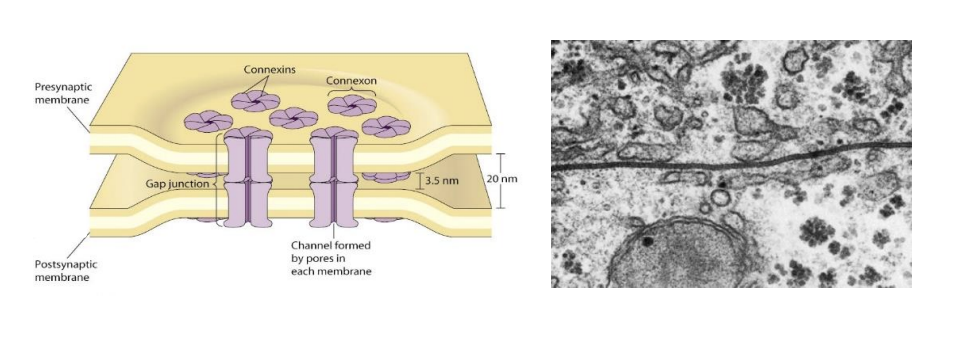
Final proof of a presence of the gap/ synaptic cleft
Charles Herrington:
Demonstrated unidirectional spinal reflexes
delay directionalilty and ability of presynaptic depolarisaion to cause postsynaptic hyperpolarisation
could only be explained by the existence of a chemical cleft or synpase
subsequeny disocveries further confirms the chemical nature of neurotransmission cementing the neuron doctrine
Neutransmitter clearance from the cleft: why must this happen
must be cleared rapidly to preserve temporal precision
Ways clearance can occur
Diffusion away
Enzymatic breakdown
acetylcholine broken down by acetylcholinesterase)
Reuptake via specialised plasma membrane transporters
Reuptake is especially important: how does it work
Transporters use the sodium electrochemical gradient to import neurotransmitters
energetic cost is paid by the pumps that maintain this gradient for the membrane potential
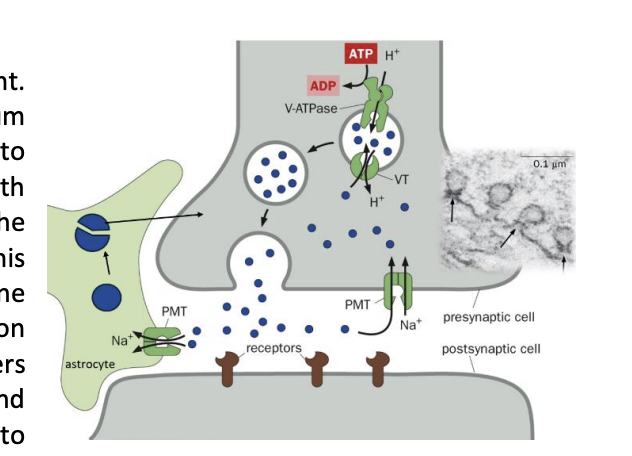
If neurotransmitters are on astrocytes…
neurotransmitters are:
taken up
broken down
precursors are shuttled back to neurons
IF neurotransmitters are on the presynaptic terminal
Neurotransmitters are not degraded
instead
immedicately repacked into vesicles
What does this ensure
continuous transmission
Why is clearnace deliberately slow in some synapses?
allows spillover to neirghbouring synapses and extrasynaptic receptors
Pre-synaptic protein of interest: alpha-Synulcein→ features
140-amino acid
SNCA-encoded presynaptic protein
Pre-synaptic protein of interest: alpha-Synulcein→ what is its role
regulates neurotransmitter release
and
reuptake
by
interacting with SNARE proteins
Pre-synaptic protein of interest: alpha-Synulcein: what happens when it is mutated
misfolds into Lewy bodies
aggregates that spread and disrupt synaptic function
→ defining Parkinson’s disease and Lewy body dementia
Three man chemical groups of neurotransmitters
Amino acids
glutamate (main excitatory)
GABA (main inhibitory)
glycine (another inhibitory)
Esters
ACh→ for neuromuscular junction and for the brain
Monoamines
Dopamine
noradrenaline
adrenaline (catecholamines)
serotonin
histamine
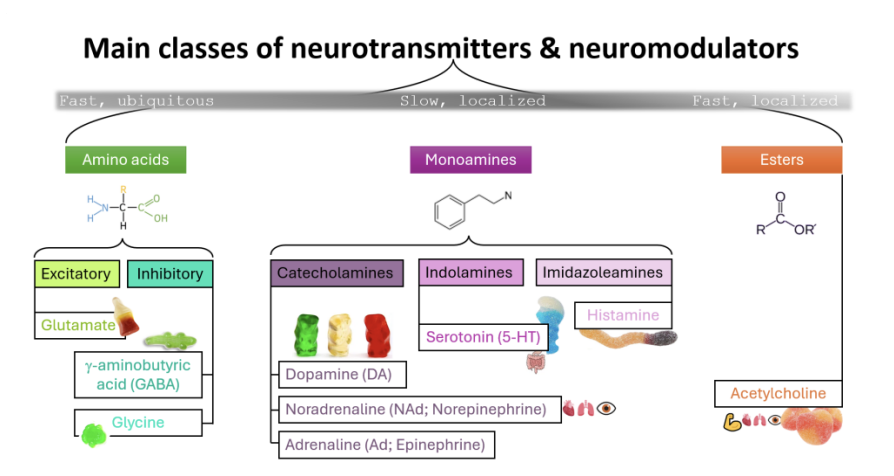
They have different properties
Amino acids and acetylcholine→ act quickly
Monomines→ act more diffusely and more slowly
this is why they are sometimes called neuromodulators
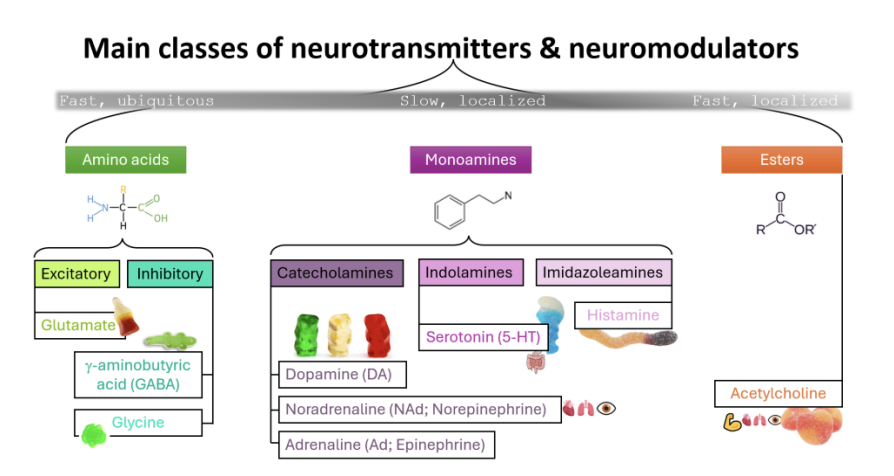
some transmitter are produced by only…
small groups of neurons
However, they can still be effect across the entrire brain because…
their axons project widley
Example 1: Acetylcholine:
in nuclei of the basal forebrain and brain stem
but
its projections influence sleep-wake cycles and memory
its los→ alzherimers
Example 1: Acetylcholine: organophosphate poising
illustrates the danger of disrupting acetylcholine lcearnace
What happens:
prevents acetylcholinesterase from breaking it down
leads to uncontrolled signalling
eventually respiratory-failture
Example:2 Serotonin
produced by neurons of the raphe nuclei in the brainstem
equally widespread projections
Example:2 Serotonin, what does it regulate
mood, appetite, pain and sleep
Example:2 Serotonin, what does dysfunction of serotonergic systmes cause
associated with depression, anxiety and schizophenia
Example:2 Serotonin: Drugs to prolong serotonin’s action
SSRIs (e.g fluoxetine/Prozac)
prolong serotonin action in the cleft by blocking reuptake, improving symptoms of mood disorders
Example 3: Dopamine
small localised production→ wide-spanning impact:
neurons in substantia nigra progect to the striatum in the nigrostriatal pathway
essential for movement
DEGREDATION→ PArkinson’s disease
Example 3: Dopamine: neurons in the neighbouring ventral tegmental area…
project more broadly to limbic and cortical regions
where disruption of dopamine transmission is linked to psychosis and schizophenia
Example 3: Dopamine: Another→ small hypothalamic population projects…
the pituitary glands
regulates hormone release for lactation
Example 3: Doapmine: the catecholamine family forms…
a biochemical chain from tyrosine
through L-SOPA → dopamine→ noradrenaline→ adrenaline
drugs can act at multiple steps in this pathway:
L-DOPA therapy in Parkinson’s
Enzyme inhibitors used for hypertension or addition
Neuropeptides and promiscuous release: Dale’s principle
The same chemical transmitter is released from all the synaptic terminals of a neuron
However:
This is far too simple
Why is it far too simple?
Neuropeptides add complexity
What are neuropeptides
short amino acid chains
longer than classical transmitters
shorter than hormones
Examples of neuropeptides
substance P
vasopressin
somatostatin
endorphins
glucagon-like peptide-1 (GLP-1)
Where are they synthesised and released
Synthesised in soma
transported to terminal
often co-released with fast transmitters like glutamate
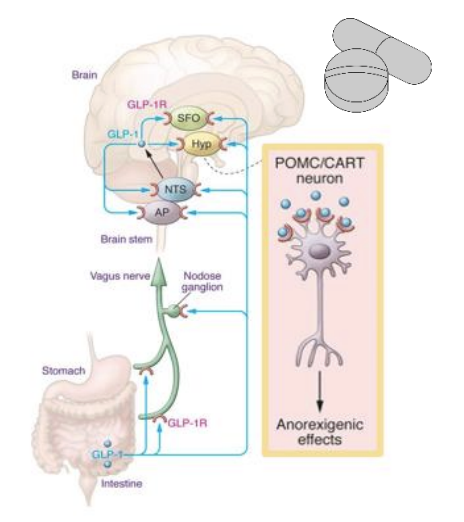
Roles of Peptides
act at low concentrations
produce long-lasting effects
→play key roles in physiology and disease
Example: GLP-1
naturally released from gut cells and brainstem neurons
after food intake
→ SIgnals satiety
Example: GLP-1:How does it signal satiety
acting on postsynaptic receptors in the hypothalamus
Example: GLP-1: theraputic agonists
e.g Ozempic
mimic this peptide
have much longer half-life
proloning ‘full'ness’
→ reduciing food intake
Neurones also engage in
Co-transmission
Co-release
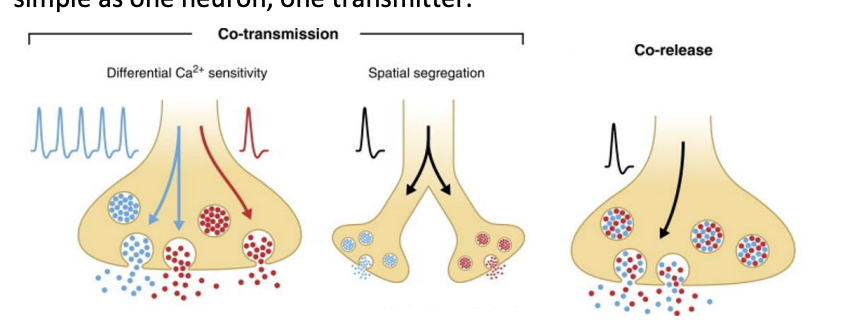
Co-transmission
maining separate vescicle pools for different transmitter
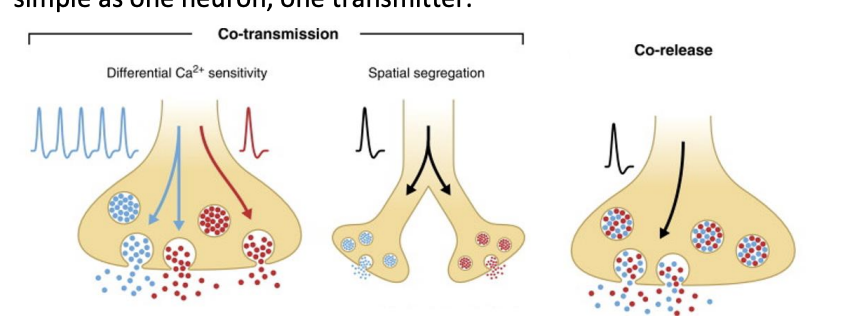
co-release
single vesicle contains more than one transmitter
e.g glutamate and GABA
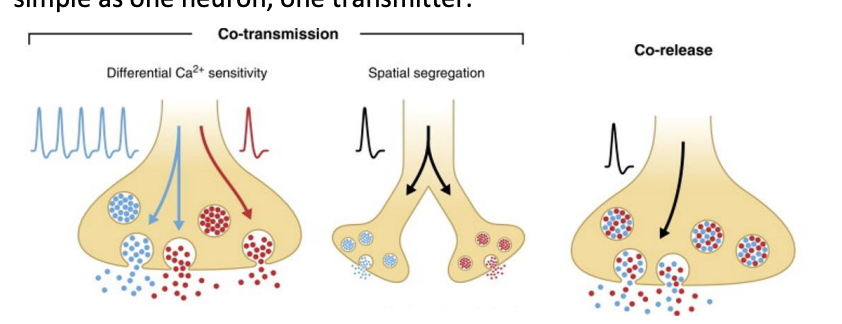
This promiscuity of signalling shows that…
neurotransmission is rarely as simple as one neuron, one transmitter
New generation of genetically encoded tool allows us to…
e.g ‘sniffers’
allows us to directly visualise neurotransmitter release in real time
Example: GABA sniffer
derived from fluorecent bacterial proteins
glows green when it detets GABA in the synaptic cleft
When combined with electrophysiology, this provides …
a simultaneous readout of pre-and postsynaptic activity
These approaches reveal that…
neurotransmitter signalling is:
messy, promiscuous and diverse
modern tools let us capture that complexity in action